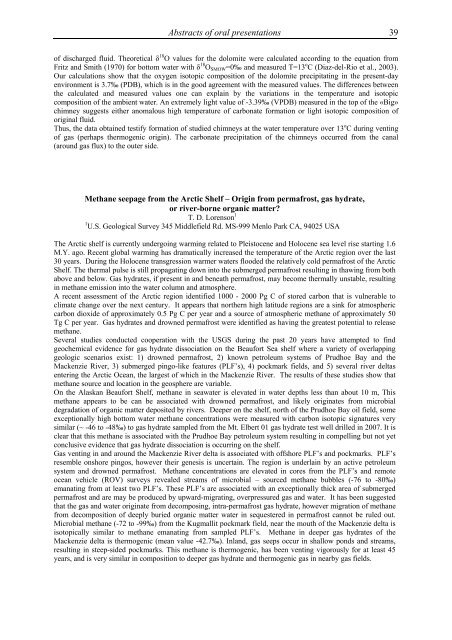Ninth international conference on - Marum
Ninth international conference on - Marum
Ninth international conference on - Marum
You also want an ePaper? Increase the reach of your titles
YUMPU automatically turns print PDFs into web optimized ePapers that Google loves.
Abstracts of oral presentati<strong>on</strong>s 39<br />
of discharged fluid. Theoretical δ 18 O values for the dolomite were calculated according to the equati<strong>on</strong> from<br />
Fritz and Smith (1970) for bottom water with δ 18 OSMOW=0‰ and measured T=13 o C (Diaz-del-Rio et al., 2003).<br />
Our calculati<strong>on</strong>s show that the oxygen isotopic compositi<strong>on</strong> of the dolomite precipitating in the present-day<br />
envir<strong>on</strong>ment is 3.7‰ (PDB), which is in the good agreement with the measured values. The differences between<br />
the calculated and measured values <strong>on</strong>e can explain by the variati<strong>on</strong>s in the temperature and isotopic<br />
compositi<strong>on</strong> of the ambient water. An extremely light value of -3.39‰ (VPDB) measured in the top of the «Big»<br />
chimney suggests either anomalous high temperature of carb<strong>on</strong>ate formati<strong>on</strong> or light isotopic compositi<strong>on</strong> of<br />
original fluid.<br />
Thus, the data obtained testify formati<strong>on</strong> of studied chimneys at the water temperature over 13 o C during venting<br />
of gas (perhaps thermogenic origin). The carb<strong>on</strong>ate precipitati<strong>on</strong> of the chimneys occurred from the canal<br />
(around gas flux) to the outer side.<br />
Methane seepage from the Arctic Shelf – Origin from permafrost, gas hydrate,<br />
or river-borne organic matter?<br />
T. D. Lorens<strong>on</strong> 1<br />
1 U.S. Geological Survey 345 Middlefield Rd. MS-999 Menlo Park CA, 94025 USA<br />
The Arctic shelf is currently undergoing warming related to Pleistocene and Holocene sea level rise starting 1.6<br />
M.Y. ago. Recent global warming has dramatically increased the temperature of the Arctic regi<strong>on</strong> over the last<br />
30 years. During the Holocene transgressi<strong>on</strong> warmer waters flooded the relatively cold permafrost of the Arctic<br />
Shelf. The thermal pulse is still propagating down into the submerged permafrost resulting in thawing from both<br />
above and below. Gas hydrates, if present in and beneath permafrost, may become thermally unstable, resulting<br />
in methane emissi<strong>on</strong> into the water column and atmosphere.<br />
A recent assessment of the Arctic regi<strong>on</strong> identified 1000 - 2000 Pg C of stored carb<strong>on</strong> that is vulnerable to<br />
climate change over the next century. It appears that northern high latitude regi<strong>on</strong>s are a sink for atmospheric<br />
carb<strong>on</strong> dioxide of approximately 0.5 Pg C per year and a source of atmospheric methane of approximately 50<br />
Tg C per year. Gas hydrates and drowned permafrost were identified as having the greatest potential to release<br />
methane.<br />
Several studies c<strong>on</strong>ducted cooperati<strong>on</strong> with the USGS during the past 20 years have attempted to find<br />
geochemical evidence for gas hydrate dissociati<strong>on</strong> <strong>on</strong> the Beaufort Sea shelf where a variety of overlapping<br />
geologic scenarios exist: 1) drowned permafrost, 2) known petroleum systems of Prudhoe Bay and the<br />
Mackenzie River, 3) submerged pingo-like features (PLF’s), 4) pockmark fields, and 5) several river deltas<br />
entering the Arctic Ocean, the largest of which in the Mackenzie River. The results of these studies show that<br />
methane source and locati<strong>on</strong> in the geosphere are variable.<br />
On the Alaskan Beaufort Shelf, methane in seawater is elevated in water depths less than about 10 m, This<br />
methane appears to be can be associated with drowned permafrost, and likely originates from microbial<br />
degradati<strong>on</strong> of organic matter deposited by rivers. Deeper <strong>on</strong> the shelf, north of the Prudhoe Bay oil field, some<br />
excepti<strong>on</strong>ally high bottom water methane c<strong>on</strong>centrati<strong>on</strong>s were measured with carb<strong>on</strong> isotopic signatures very<br />
similar (~ -46 to -48‰) to gas hydrate sampled from the Mt. Elbert 01 gas hydrate test well drilled in 2007. It is<br />
clear that this methane is associated with the Prudhoe Bay petroleum system resulting in compelling but not yet<br />
c<strong>on</strong>clusive evidence that gas hydrate dissociati<strong>on</strong> is occurring <strong>on</strong> the shelf.<br />
Gas venting in and around the Mackenzie River delta is associated with offshore PLF’s and pockmarks. PLF’s<br />
resemble <strong>on</strong>shore pingos, however their genesis is uncertain. The regi<strong>on</strong> is underlain by an active petroleum<br />
system and drowned permafrost. Methane c<strong>on</strong>centrati<strong>on</strong>s are elevated in cores from the PLF’s and remote<br />
ocean vehicle (ROV) surveys revealed streams of microbial – sourced methane bubbles (-76 to -80‰)<br />
emanating from at least two PLF’s. These PLF’s are associated with an excepti<strong>on</strong>ally thick area of submerged<br />
permafrost and are may be produced by upward-migrating, overpressured gas and water. It has been suggested<br />
that the gas and water originate from decomposing, intra-permafrost gas hydrate, however migrati<strong>on</strong> of methane<br />
from decompositi<strong>on</strong> of deeply buried organic matter water in sequestered in permafrost cannot be ruled out.<br />
Microbial methane (-72 to -99‰) from the Kugmallit pockmark field, near the mouth of the Mackenzie delta is<br />
isotopically similar to methane emanating from sampled PLF’s. Methane in deeper gas hydrates of the<br />
Mackenzie delta is thermogenic (mean value -42.7‰). Inland, gas seeps occur in shallow p<strong>on</strong>ds and streams,<br />
resulting in steep-sided pockmarks. This methane is thermogenic, has been venting vigorously for at least 45<br />
years, and is very similar in compositi<strong>on</strong> to deeper gas hydrate and thermogenic gas in nearby gas fields.














